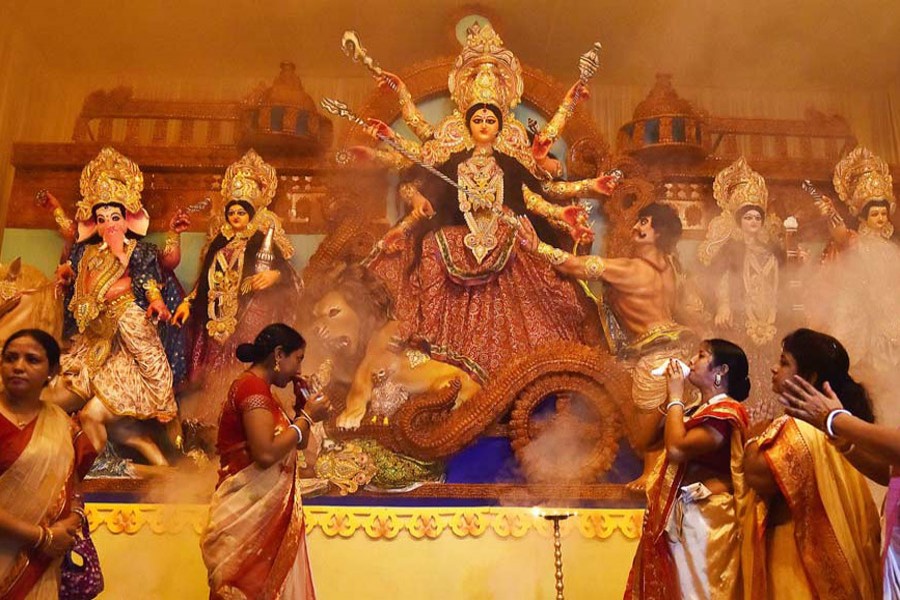The Bangalee Hindus' greatest annual festival Durga Puja spanning over long five days came to an end on Tuesday last. It surely is a religious festival as puja (worship) is offered complying with various rites and rituals as enshrined in scriptures, but then indisputably it is more a social event than a religious function. It is notable that only the Bangalee Hindus celebrate the occasion in a festive mood. However, in JharKhand of Bihar, Odissa, Assam and Tripura Goddess Durga is worshipped in a befitting manner. The first Durga Puja was recorded in the late 1500's. Folklore has it that zamindars of Dinajpur and Malda were the ones to initiate the puja. Another version claims that Maharaja Krishna Chandra introduced it in the late 17th century.
Although the worship of the goddess is mentioned in Ramayana, experts are of the opinion that it was a later addition to the Kirtibasi Ramayana in the 8th century. That followers of Hinduism in southern India have rather a different festival called Dashera on the day Durga is immersed.
Here is a religious occasion where deity and daughter conceptually come together to be inseparable. Uma the other name of Goddess Durga is on a visit to her parental home and she comes accompanied by her sons and daughters. Why the statuses of a deity and daughter are interchanged perhaps lies in the Bangalee psyche. The goddess who is the embodiment of power, who is unconquerable and destroys the monsters other gods and goddesses have failed to overcome is not supposed to be equated with a defenceless daughter in her in-law's home.
Perhaps here the dilemma of mind in a patriarchal society is fully exposed. People have accepted the description of the deity in the old scriptures written by sages but at the same time they are not at ease with the absolute power that she wields. This does not mean that they are totally against the feminine power but unless it is mellowed to their liking they cannot fully accept her sway.
So she becomes a daughter who can be greeted with love and care and can be given farewell in tears. If the evolution of Durga finds its link to the war goddess from Mesopotemia on the basin of Ufretis and Tigris, she has transformed throughout ages to take the present shape of 10 hands all yielding different weapons and riding a lion she is killing the demon who hid himself in a buffalo. Clearly, myth and religious scriptures contributed to her evolution as a goddess and there lies the mystery of the socio-cultural aspects gaining over the religious formalities.
What is particularly interesting is the unique opportunity of accepting the festival's relevance without being a particular adherent to idol worshipping. The idols are a kind of art work not quite sculptures to be stored in museum for exhibition. But these are embellished exquisitely so that right from a formative age a child can develop love for aesthetic beauty. Female figures are at their most adorable. At the same time the virtues they are supposed to be the embodiment are equally appealing. Goddess Durga's two sons also represent valour and cool head respectively. And finally, they all are all at war with the demon representing the dark forces. So here is a war between the good and evil. Unless one is a follower of communism, this is the guiding principle of worshipping Durga. However a radical line taken by some interprets it as the supremacy of the Aryan Brahmins -the highest race and caste in order -- over the local dark coloured people.
Be that what it may, the common people have viewed Durga Puja as a homely affair where their daughter incarnation visits their homes every year and take leave after five days. Feminine power or mother power gets somewhat suppressed. But at another level, it is certainly an invocation of the power within. One must explore the inner strength in order to fight injustice and evil all around. In a world not known particularly for equal treatment of all, there is a need for announcing one's strength on even terms so that the suppressors know that they are pitted against adversaries who are unwilling to give any ground without a fight. Let Durga Puja get the message across that no one is more equal than others; as civilised people all should enjoy equal opportunities and treatment.


